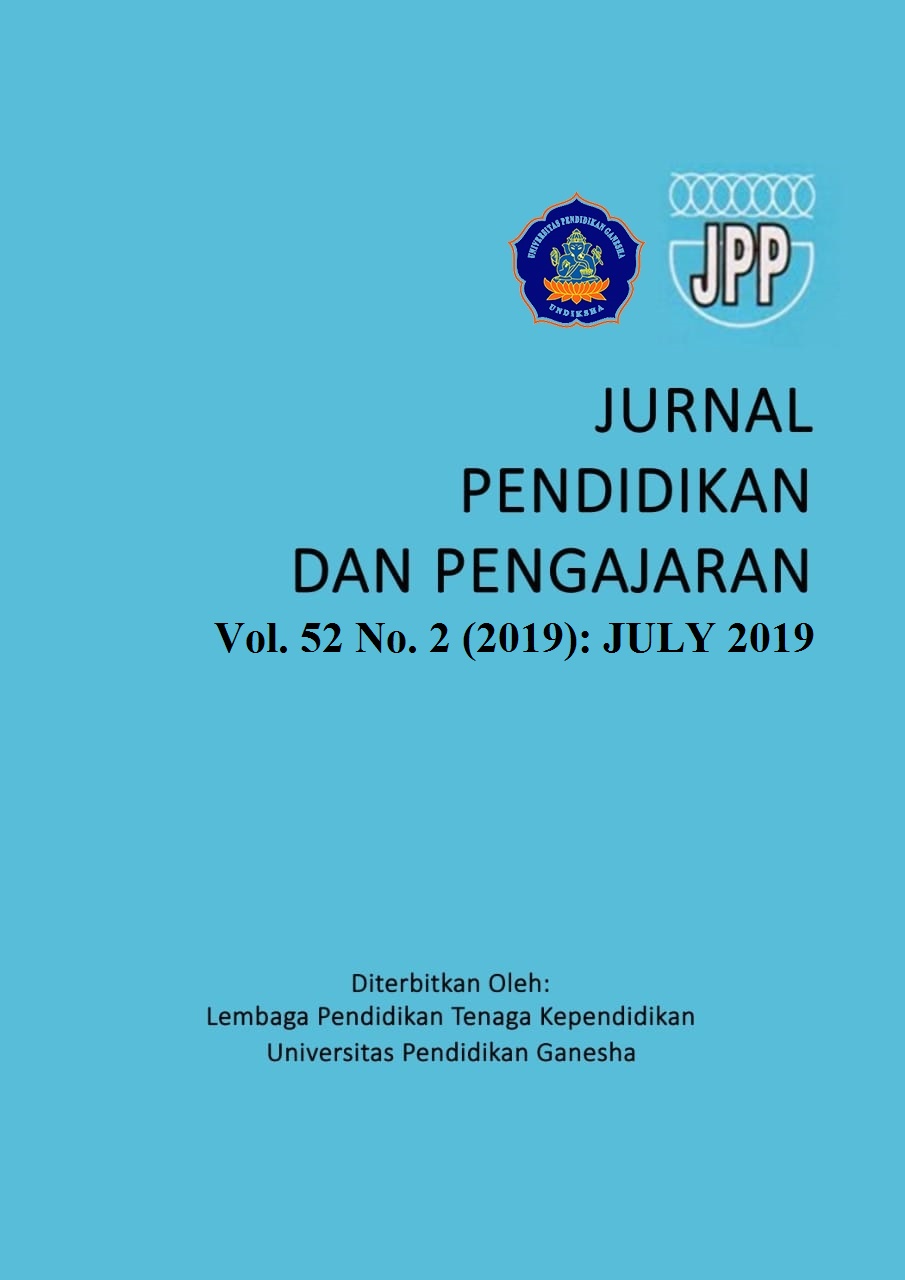Improvement of primary school students’ activeness and outcome using discovery learning model in mathematics
DOI:
https://doi.org/10.23887/jpp.v52i2.18261Keywords:
discovery learning model, activeness, learning outcome, mathematicsAbstract
This study aims to determine the increase in activity and learning outcomes of 5th grade students of SD Negeri Randuacir 02 Salatiga Semester II Year 2018/2019 using the discovery learning model. This type of research is classroom action research (CAR). The research subjects were 29 students in grade 5. Procedure for classroom action research in the form of planning, implementation, observation and reflection. The action was carried out in two cycles with each cycle of three meetings. Data collection techniques in this study used observation and tests. The data analysis technique is done by using descriptive comparative analysis in the form of a percentage comparison in the initial conditions before the action is taken, the results of the first cycle, and the results of the second cycle. The results showed an increase in the activeness and learning outcomes of mathematics through the implementation of the discovery learning model. This is evidenced in the rubric of the activity of the first cycle, the average value is 29.66, the criteria are quite good, increasing in the second cycle with the average score being 45.03 criteria very good. The learning outcomes with the KKM provisions are 70, in the pre-cycle only 17.24% were completed, in the first cycle it increased to 55.18%, and in the second cycle the action increased to 72.41%.References
Anugraheni, I. (2017). Penggunaan portofolio dalam perkuliahan penilaian pembelajaran. Jurnal Pendidikan Dasar Perkhasa: Jurnal Penelitian Pendidikan Dasar, 3(1), 246-258.
Balım, A. G. (2009). The Effects of Discovery Learning on Students ’ Success and Inquiry Learning Skills. Egitim Arastirmalari-Eurasian Journal of Educational Research, 35, 1–20.
Behzadan, A. H., & Kamat, V. R. (2013). Enabling discovery ‐ based learning in construction using telepresent augmented reality. Automation in Construction, 33, 3–10. https://doi.org/10.1016/j.autcon.2012.09.003
Budiningsih, A. 2005. Belajar dan Pembelajaran. Jakarta: Rineka Cipta.
Gijlers, H., & Jong, T. De. (2005). The Relation between Prior Knowledge and Students ’ Collaborative Discovery Learning Processes. Journal of Research in Science Teaching, 42(3), 264–282. https://doi.org/10.1002/tea.20056
Hartono, K. (2014). Meningkatkan Keaktifan dan Hasil Belajar Matematika Melalui Model Pembelajaran Jigsaw. Ekuivalen-Pendidikan Matematika. 14 (2), 100.
In’am, A., & Hajar, S. (2017). Learning Geometry through Discovery Learning Using a Scientific Approach. International Journal of Instruction E-ISSN:, 10(1), 55–70.
Kristin, F., & Rahayu, D. (2016). Pengaruh penerapan model pembelajaran discovery learning terhadap hasil belajar IPS pada siswa kelas 4 SD. Scholaria: Jurnal Pendidikan & Kebudayaan, 6(1), 84-92.
Kristin, F. (2016). Analisis model pembelajaran discovery learning dalan meningkatkan hasil belajar siswa SD. Jurnal Pendidikan Dasar Perkhasa, 2(1), 90-98.
Maharani, Y. B., & Hardini, I. T. A. (2017). Penerapan model pembelajaran discovery learning berbantuan benda konkret untuk meningkatkan hasil belajar IPA. Jurnal Mitra Pendidikan, 1 (5), 249-561.
Pamungkas, A. D. (2018). Meningkatkan Keaktifan dan Hasil Belajar Siswa Melalui Model Pembelajaran Problem Based Learning (PBL) pada Siswa Kelas 4 SD. Naturalistic: Jurnal Kajian Penelitian Pendidikan dan Pembelajaran Vol.3, 287-293.
Prasad, K. S. (2011). Learning mathematics by discovery. Academic Voices, 1(1), 31–33.
Saab, N., Joolingen, W. R. Van, & Hout-wolters, B. H. A. M. Van. (2005). Communication in collaborative discovery learning. British Journal of Educational Psychology, 75, 603–621. https://doi.org/10.1348/000709905X42905
Sardiman. (2001). Interaksi dan Motivasi Belajar Mengajar. Jakarta: PT Raja Grafindo Persada.
Slameto. (2010). Belajar dan Faktor-Faktor yang Mempengaruhinya. Jakarta: Rineka Cipta.
Supriyanto, B. (2014). Penerapan Discovery Learning untuk Meningkatkan Hasil Belajar Siswa Kelas VI B Mata Pelajaran Matematika Pokok Bahasan Keliling dan Luas Lingkaran di SDN Tanggul Wetan 02 Kecamatan Tanggul Kabupaten Jember. Pancaran Pendidikan, 3(2), 165-174.
Tompo, B., Ahmad, A., & Muris, M. (2016). The Development of Discovery-Inquiry Learning Model to Reduce the Science Misconceptions of Junior High School Students. International Journal of Environmental and Science Education, 11(12), 5676–5686.
Tran, T., Noi, H., Nguyen, N., Noi, H., Bui, M., Noi, H., … An, N. (2014). Discovery Learning with the Help of the GeoGebra Dynamic Geometry Software. International Journal of Learning, Teaching and Educational Research, 7(1), 44–57.
Downloads
Published
How to Cite
Issue
Section
License
Authors who publish with Jurnal Pendidikan dan Pengajaran agree to the following terms:- Authors retain copyright and grant the journal the right of first publication with the work simultaneously licensed under a Creative Commons Attribution License (CC BY-SA 4.0) that allows others to share the work with an acknowledgment of the work's authorship and initial publication in this journal
- Authors are able to enter into separate, additional contractual arrangements for the non-exclusive distribution of the journal's published version of the work (e.g., post it to an institutional repository or publish it in a book), with an acknowledgment of its initial publication in this journal.
- Authors are permitted and encouraged to post their work online (e.g., in institutional repositories or on their website) prior to and during the submission process, as it can lead to productive exchanges, as well as earlier and greater citation of published work. (See The Effect of Open Access)





